Nicole Ondre
Torsion
Opening – 26 APR 2024, 6-9 pm
Kurfürstenstraße 156
Tanya Leighton, Berlin is pleased to announce ‘Torsion’, a solo exhibition by Nicole Ondre, presenting a continuation of her work that investigates the intersection of ceramics and theoretical knots.
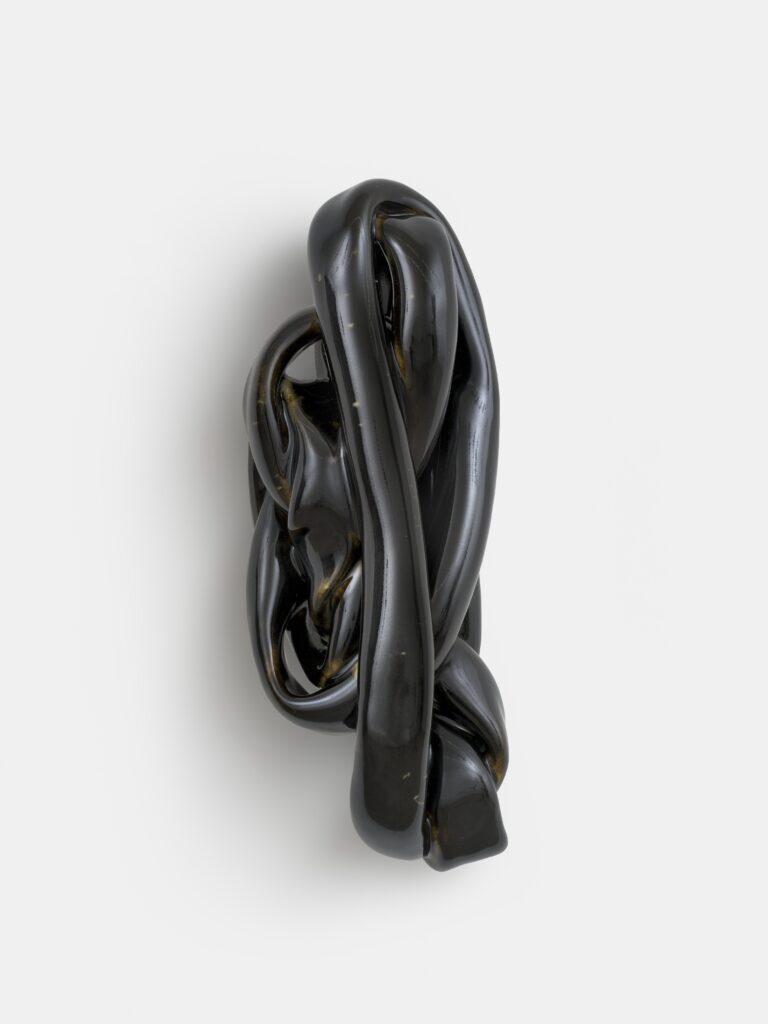
Nicole Ondre
9₃₆, 2024
Glazed ceramic
Unique
(ONDRE-2024-0071)
Courtesy of the artist and Tanya Leighton, Berlin and Los Angeles
Photography: Gunter Lepkowski
The knotting and twisting clay of Ondre’s sculpture derive from her study of mathematical knot theory. In the field of topology, theoretical knots are constructs used to study the properties and behaviour of form in a purely abstract sense, divorced from physical materiality. Ondre brings the hypothetical into the real, transforming simplified, two-dimensional diagrams into complex, entangled configurations of clay.
The clay’s material transformation references Ondre’s interest in textile patterns. The forms are folded, stretched, and distorted and express the physical realities of gravity, compression, and extension through the sculptures’ curves. This is not only evident in the stitch-like sequences of certain works and the haptic process of creation but also in the draped, coiled pieces that fold over themselves. The works contain the heaviness and gravity of fabrics depicted in Renaissance painting, such as pleated velvet curtains that frame a Biblical scene or brocade robes that drape over the Virgin Mary. They harken back to a painting tradition that Ondre practised prior to ceramics. The coiling, hanging sculptures demonstrate a sort of sprezzatura – to borrow a term from the 15th century. There is an effortlessness in the draped forms that masks the tension of twisted clay and the material’s metamorphosis in the kiln.
Ondre’s serpentine sculptures undulate in glossy varnishes and deep hues, some in a dark metallic, others in a bright teal, which derive from her adoption of copper in several glazes. Using this mineral engenders a form of contingency or chance, opening a liminal space where there is intention and control (and the release of both). Copper, in this equation, reacts to heat, time, and the atmospheric conditions of the kiln, which can result in either a dusky pink or a vivid turquoise.
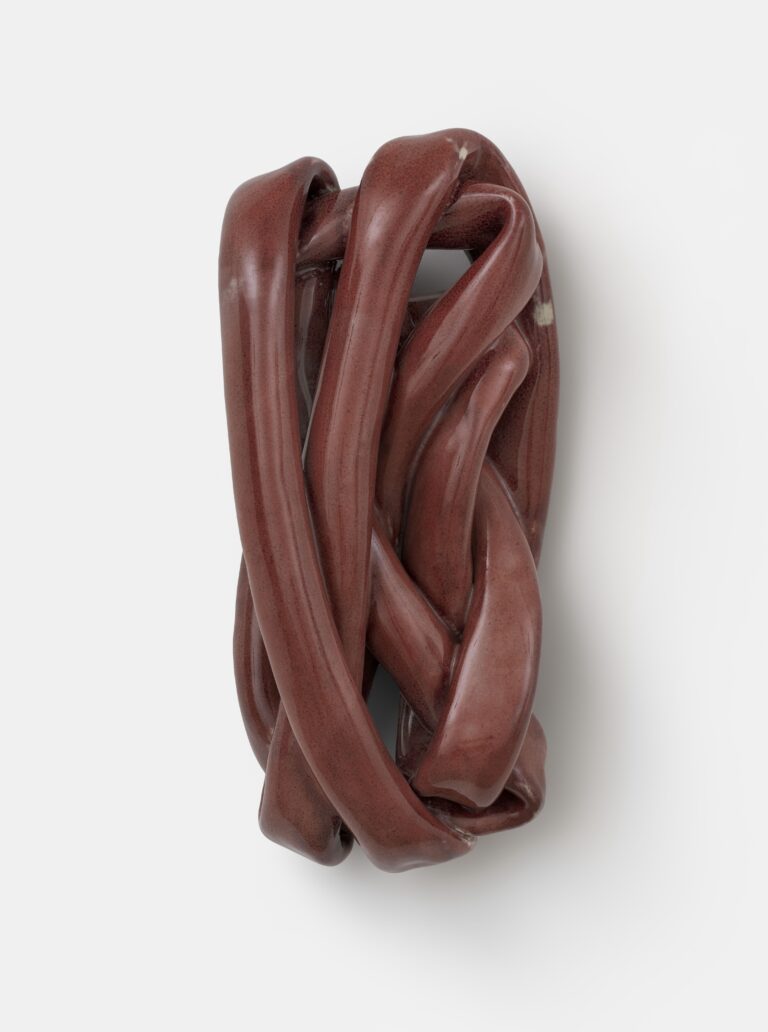
Nicole Ondre
9₄₄, 2024
Glazed ceramic
Unique
(ONDRE-2024-0072)
Courtesy of the artist and Tanya Leighton, Berlin and Los Angeles
Photography: Gunter Lepkowski
The ancient, or the primordial, is physically embedded in the works. It is not just metaphorical but rather an intrinsic part of the material itself. Clay contains particles that are millions of years old. Ceramic shards and figurines are amongst the oldest human records. Clay remembers. A bump or dent, even if apparently fixed, may reappear in the firing process. Firing, then, is a sort of alchemical magic. It is a combination of temperature, glaze chemistry, time and oxygen in the kiln. It is the tactile sculpting of the practitioner and the memory of the clay itself.
Ondre’s practice expands the vocabulary of abstraction and invites contemplation on the interplay of chance and intention, evoking a transitional realm where both control and spontaneity find expression.
Elizabeth McIntosh
Grow Up
Opening – 26 APR 2024, 6-9 pm
Kurfürstenstraße 24/25
Tanya Leighton, Berlin, is pleased to announce ‘Grow Up’, a solo-exhibition by Elizabeth McIntosh. An experiment in graphic abstraction, McIntosh’s paintings are a joyful assemblage of colours and forms that parade across the canvas.
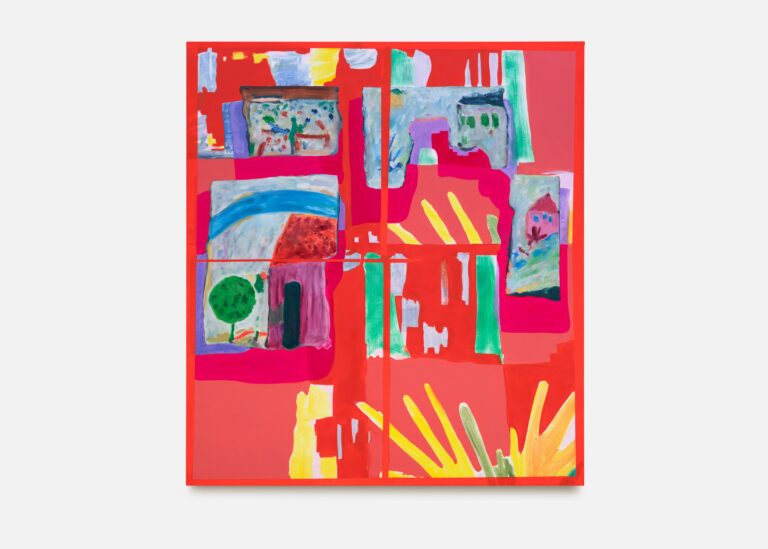
Elizabeth McIntosh
Mother Puzzle, 2024
Oil on canvas
129.5×144.8×2.5 cm
51×57×1 In
Unique
(MCINTOSH-2024-0069)
Courtesy of the artist and Tanya Leighton, Berlin and Los Angeles
Photography: Rachel Topham Photography
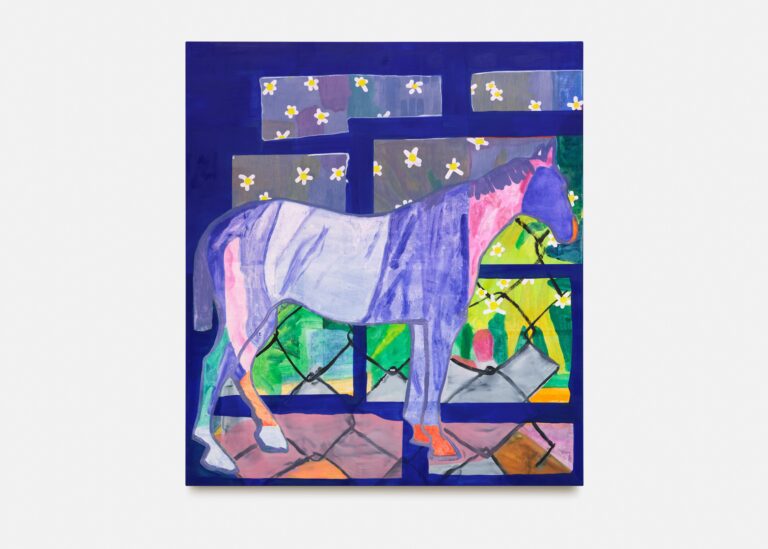
Elizabeth McIntosh
Horse Land, 2024
Oil on canvas
129.5×144.8×2.5 cm
51×57×1 In
Unique
(MCINTOSH-2024-0070)
Courtesy of the artist and Tanya Leighton, Berlin and Los Angeles
Photography: Rachel Topham Photography
‘Grow Up’ can be read as an act of imploration, as a finger wagging playfully, as a joke between friends. It is tongue in cheek, which is to say that it can be construed differently depending on the cadence of speech or intonation. ‘Grow Up’ is also quite literally a large graffiti tag in Vancouver that McIntosh snapped a photo of as she drove by it. This kind of foraging approach – collecting found images, references, snippets of art history or sketches from McIntosh’s own sketchbook – is immediately apparent in the stratified blocks and swathes of colours and forms (a collage-effect that harkens back to former bodies of work). Yet, in typical fashion, McIntosh’s paintings also display a playful approach, a constant experimentation akin to ‘growing up’: they are learning, employing intuition, adjusting based on past experience.
McIntosh employs the use of frames that act as latticed windows into the works. The layers and transparencies create a peripheral space that make the viewer aware of the process of looking. We are implicated in our gaze as we puzzle through the forms and figures on the canvas. There is a mischievous sort of reciprocity between McIntosh, the work and her audience. While this layering could have a distancing effect – bordering on voyeurism – it is also a channel for intimacy (like being able to glimpse into a family home at dusk before they draw the curtains, looking into a space that is both alien and familiar).
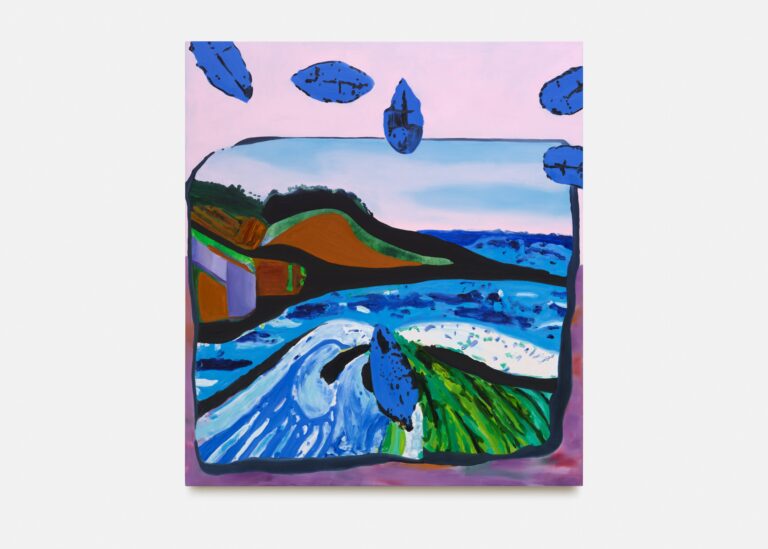
Elizabeth McIntosh
Goodbye, 2024
Oil on canvas
129.5×144.8×2.5 cm
51×57×1 In
Unique
(MCINTOSH-2024-0071)
Courtesy of the artist and Tanya Leighton, Berlin and Los Angeles
Photography: Rachel Topham Photography
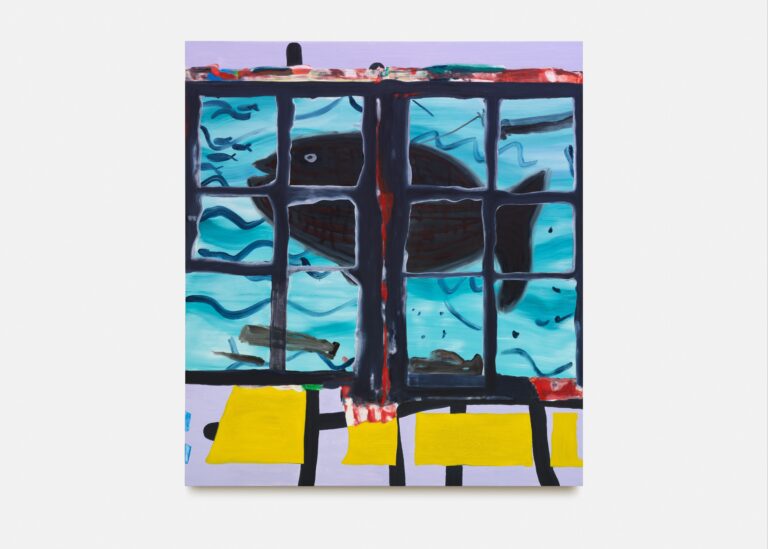
Elizabeth McIntosh
See Through, 2024
Oil on canvas
129.5×144.8×2.5 cm
51×57×1 In
Unique
(MCINTOSH-2024-0073)
Courtesy of the artist and Tanya Leighton, Berlin and Los Angeles
Photography: Rachel Topham Photography
McIntosh also draws on visual quotations from the early modernist era of painting – a time that was ripe with experimentation, directness and new formal structures – as well as her own doodles, memories, or family photos. While the background may feature appropriated imagery, the main protagonists of her canvases are drawn from life.
The works oscillate between figuration and abstraction, improvisation and design. McIntosh deftly interweaves blocks of canary yellow or lavender, while in the foreground a large black fish peeks out from a latticed window. She dances between references that interweave cropped figurations from art history with a strawberry or an ice cream cone: motifs taken from her daughter’s embroidered suede purse.
McIntosh’s approach embodies improvisation that mirrors a form of play. It feels that we, as viewers, are learning and inventing alongside McIntosh in ‘Grow Up’, in a gentle homage to a youth that slips through our fingers when we’re not looking, perhaps only able to be remembered via paint on canvas.
